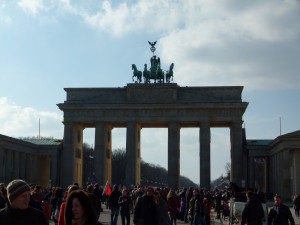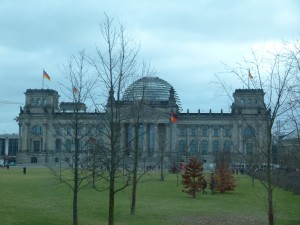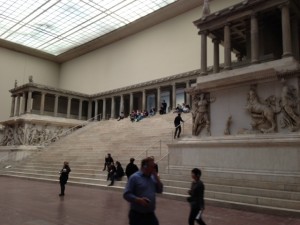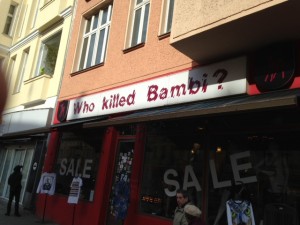Berlin, Part II
Posted on March 7, 2013
Berlin is not a beautiful city. Where Paris dazzles and London charms and Rome surrounds you with 2000 years of history, Berlin was almost leveled in WWII and block after city block is full of post-war construction. The best of it mimics the lines and style of the buildings that came before and the worst looks like drab Soviet style brutalism, though ironically and because of massive targeted investments in the east, more of that dour construction seems to be in the west. That said, Berlin feels very livable (you have to be pretty wealthy to live in Paris and London and Rome just doesn’t work very well). It has beautiful large parks, the Tiergarten being the best known, and little neighborhood parks with playgrounds. It has street markets and street food, fabulous public transport, and the cost of housing remains a fraction of other capitals and even other German cities.
It’s also a thoroughly youthful city, including infants. The German government wants to encourage young couples to have more babies (thus the aforementioned generous support) and they seem to be dutifully obeying those wishes. There are babies everywhere and as many baby carriages as bicycles. I must say, Germans do make cute babies, all blond hair and red cheeked in the cold (that German heartiness starts young). In fact, the city is a magnet for twenty-somethings from all over Europe, hipsters and slackers and aspiring artists of every stripe. There is a vibrant music and club scene (here’s a pretty funny, but insightful NY Times piece: http://www.nytimes.com/2012/11/25/magazine/in-berlin-you-never-have-to-stop.html?pagewanted=all&_r=0). There are art galleries and fashion – mandatory color is black — and it’s cheap. So much so that the government is actually hoping to see a rise in prices to produce more tax revenue and a better demographic balance.
Berlin is not without its grand locations. The Unter Den Linden is the city’s grand boulevard and leads to the iconic Brandenburg Gate.
Along the way are the Dom, the city’s ornate cathedral, Museum Island and its five blockbuster museums, the esteemed Humboldt University, embassies, and more. And the city is bustling with new and bold architecture, including Daniel Libeskind’s striking Jewish Museum (Libeskind is the architect of NYC’s Freedom Tower replacing the destroyed Twin Towers) and Sir Norman Foster’s amazing dome on the Reichstag, the German Parliament building.
There are construction cranes everywhere.
Highlights on our strolls through the city included the following:
The Pergamon Museum, housing the best antiquities collection in Europe and maybe the world. Germany has always been a powerhouse of archeology and that tradition is on dazzling display in the Pergamon, where huge installations start the moment you enter the first gallery and see the monumental Pergamon Alter sprawled across the massive room (it is from 170 BC from the Acropolis of Pergamon in present day Turkey). The room also includes the original frieze depicting the heroic battle of the Gods and Giants, an amazing reconstruction full of drama. Take that Elgin Marbles.
Walk into the next gallery and discover the towering Miletus Market Gate (120 AD) and in the very next gallery the striking blue tile Ishtar Gate (6th C. BC) from Babylon. It is flabbergasting that a museum might have even one of these treasures and here you stroll through three of the great ancient cultures in just your first moments in the building. Upstairs is a world class Islamic Art collection and yet more large scale installations including a section of wall from Jordan’s Mshatta Palace (744 AD) and the best and oldest preserved room from an Aleppo merchant’s home (1601 AD). In addition, there are rooms full of Babylonian statuary, Roman mosaics, and Arabic carpets. It’s stunning really. And there is so much in the collections that the museum can’t hold it all, so the reconstructed Neues Museum holds the Egyptian collections.
We wandered over there and made our way to the single best known antiquity in Berlin and maybe the world, the bust of Queen Nefertiti (14C. BC). I’ve seen pictures of it and read descriptions, but seeing it for real and spending time with it was one of the best art experiences of my life. It is profound. It is, on one hand, an ideal of beauty and yet the Queen is not a youngster. There are subtle wrinkles at the corner of her eyes and mouth and is in its perfection oddly realistic. It is at once a standard of beauty and yet absolutely human. It’s an almost impossible balance this sense of “this is as good as it can get” and “I could have known this person” (though in truth I would have been a slave or slave to a slave or some such position in her court). People walking into the small room dedicated just to Nefertiti fall silent in its presence. It feels….perfect.
Profound in a slightly different way was the time we spent with the museum’s unparalleled collection of papyrus. Only a fraction of the extensive collection is on display and is made available in ingenious cases that allow you to call out various items (organized by themes like religion, philosophy, literature, science, and math) at the push of a button. Trays under glass slide out automatically and there before one’s eyes is the ancient handwriting of a scholar commenting on Homer (already ancient to that 5th C. BC reader), multiplication tables, theorems, and explications of Plato. There is something intimate about seeing someone’s handwritten script (largely lost to us in this digital age), as if you are across the centuries in direct contact with the long ago mind. I felt this way years ago in the British Museum seeing John Lennon’s original lyrics for a Beatles song with cross-outs and scribbles giving insight into his crafting of the eventual hit or when seeing illuminated manuscripts with their marginalia intact, the commentary of medieval monks.
I slip into a progressive sense of history quite often, comfortable that each successive age improves on what comes before and that we must necessarily know more and possess greater insights than our predecessors. Better thinkers than me have debunked that very Victorian notion (as have human events in the 20th C. in particular), but the point was driven home for me in these museum visits. It may be that in Nefertiti we have our most stunning depiction of human beauty and it is more than 3,000 years old. The friezes from Pergamon had gods and monsters and drama to rival any CGI film we can produce. The papyri reveal minds as engaged and avid as ours in the basic questions of how to live and how the world works. I found it humbling and somehow reassuring to be reminded that in our gee-whiz technological and globally connected world, basic humanity and creativity and a reach for the ideal is what ties us back to our ancient forebears and the study of their achievement is as important today as it ever was. In short, it is a case for our ongoing commitment to the Humanities.
A word about German as a language. To our ears it swings wildly from sounding comical (impossibly long single words for what would be a whole phrase in English) to downright scary. It’s often familiar given its influence on our own language and while the grammar seems nearly impossible, the vocabulary would be easy enough to grasp. Maybe it was the influence of too many WW II movies, but when a German museum guard commanded us to go this way and not that, we immediately complied! It just sounded menacing. While I’m sure German friends and families are as loving and informal with each other as we are (at least I like to think so, but I saw a lot less public cooing over babies of the sort you might see in Park Slope), the public face of the culture is more polite than gracious, formal than warm. One does not walk into a store or restaurant and get greeted with a smile. No one says, “Hi, I’m Hans or Helga and I’ll be your server!” Maybe that affect is amplified by Berlin being a big, busy city (New Yorkers and Parisians are not usually characterized by their easy going warmth either) and I’m not offering this observation as a criticism, but more an observation. If I can use a dog analogy, Americans seem more like Labs, energetic and happy (most of the time) and quick to please and yes, likely to do inadvertant damage even with the best of intentions, while Germans seem like….well, like German shepherds, smart and serious and focused and a little scary. This make it sound like I’m complaining, but it really is just more an observation about culture and while it might be hard to live in Berlin for a longer time, for a visitor the insistence on getting things done and done well makes a trip even easier and more reliable.
They do come up with some funny English translations and names. Here’s my favorite from a retail clothing store:
More to come.



